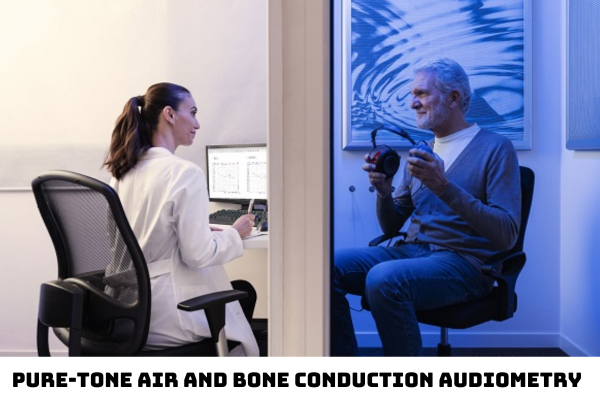Vietnam: What are the details of National Standard TCVN 11737-1:2016 on Pure-tone air and bone conduction audiometry?
- What is the scope of application and reference documents in National Standard TCVN 11737-1:2016 on Pure-tone air and bone conduction audiometry in Vietnam?
- What are the general rules for audiometric testing in Vietnam?
- What matters related to audiometric testing are professional testers in Vietnam allowed to make decisions?
What is the scope of application and reference documents in National Standard TCVN 11737-1:2016 on Pure-tone air and bone conduction audiometry in Vietnam?
In the National Standard TCVN 11737-1:2016 on Pure-tone air and bone conduction audiometry, the scope of application and reference documents in National Standard TCVN 11737-1:2016 on Pure-tone air and bone conduction audiometry in Vietnam are specified as follows:
Scope of application
This National Standard specifies the procedures and requirements for Pure-tone air and bone conduction audiometry. For screening purposes, only methods of Pure-tone air conduction audiometry are prescribed. These procedures may not be suitable for some special people, for example, children who are too young.
This National Standard does not cover audiometry procedures when measurements are taken at levels higher than the hearing threshold of tested subjects.
This National Standard does not specify procedures and requirements for speech audiometry, electrogenic audiometry, and places where speakers are used as sound sources.
Reference documents
The following reference documents are necessary for the application of This National Standard. For reference documents the year of publication, the stated version shall be applied. For reference documents without the year of publication, the latest version shall be applied, including amendments (if any).
TCVN 9595-3 (ISO/IEC Guide 98-3), Uncertainty of measurement - Part 3: Guide to the expression of uncertainty in measurement (GUM: 1995)
TCVN 11111-1 (ISO 389-1), Acoustics - Reference zero for the calibration of audiometric equipment - Part 1: Reference equivalent threshold sound pressure levels for pure tones and supra-aural earphones
TCVN 11111-2 (ISO 389-2), Acoustics - Reference zero for the calibration of audiometric equipment - Part 2: Reference equivalent threshold sound pressure levels for pure tones and insert earphones.
TCVN 11111-3:2015 (ISO 389-3:1994), Acoustics - Reference zero for the calibration of audiometric equipment - Part 3: Reference equivalent threshold vibratory force levels for pure tones and bone vibrators
TCVN 11111-5 (ISO 389-5), Acoustics - Reference zero for the calibration of audiometric equipment - Part 5: Reference equivalent threshold sound pressure levels for pure tones in the frequency range 8 kHz to 16 kHz.
TCVN 11111-8 (ISO 389-8), Acoustics - Reference zero for the calibration of audiometric equipment - Part 8: Reference equivalent threshold sound pressure levels for pure tones and circumaural earphones.
IEC 60645-1:2001, Electroacoustics - Audiological equipment - Part 1: Pure-tone audiometers.
IEC 61260, Electroacoustics - Octave-band and fractional-octave-band filters.
IEC 61672-1, Electroacoustics - Sound level meters - Part 1: Specifications.

What are the general rules for audiometric testing in Vietnam?
In subsection 4.1, Section 4 of National Standard TCVN 11737-1:2016, the general rules for audiometric testing in Vietnam are as follows:
- The hearing threshold level can be determined by bone transmission and airborne measurement. In airborne audiometry, a test signal is broadcast to the test subject through headphones.
- In bone audiometry, the test signal is transmitted by a bone fibrillator placed in the ear mastoid bone or on the forehead of the test subject.
- Those threshold level determinations should begin with airborne measurements and then use bone transmission measurements. Hearing threshold levels can be determined using fixed-frequency audiometry (fixed-frequency audiometry) or using test signals whose frequency varies over time at a predetermined rate of change (automatic frequency scanning audiometry).
- Methods of audiometry with fixed frequencies are described in Article 6, and methods of frequency scanning audiometry are described in Article 7.
In Pure-tone air and bone conduction audiometry, the hearing threshold levels of both ears will be determined individually.
- Under defined conditions, noise cover will be applied to the non-participating ear (another ear). Noise cover is fed into that ear through ear bumper-type headphones, full-ear captures, or earplugs.
What matters related to audiometric testing are professional testers in Vietnam allowed to make decisions?
In subsection 4.4 Section 4 of the National Standard TCVN 11737-1:2016, professional testers are defined as follows:
A professional tester is understood as someone who has learned the theory and practice of audiometric testing. The confirmation of this qualification may be prescribed by state management agencies or other appropriate organizations. For the entire content of this National Standard, tests are carried out only by or under the supervision of a qualified tester.
The tester may make decisions on the following matters related to audiometric testing that are not specified in detail in this National Standard, in particular:
Try the left or right ear first (usually choose the ear that is thought to be more sensitive);
- Cover requirements;
- The response of the test subject corresponds to the test signals;
- There are no external noise events or any reactive behavior of the test subject that invalidates the test;
- Pause (interrupt), end or reconduct all or part of the test.
LawNet